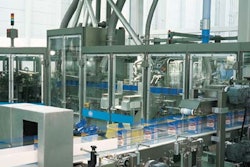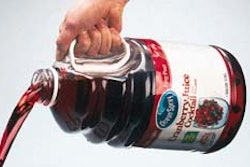For Springtown, TX, winery La Buena Vida, or “The Good Life,” life is indeed good. The small winery switched to pressure-sensitive labels for its glass wine bottles and conducted a complete label redesign, as well. An unusual p-s labeler installed in May completes the packaging upgrade.
Twenty-seven years ago, La Buena Vida’s life began as a hobby for owner Dr. Bobby Smith, a family practice physician. Now the winery has grown to a bona fide business, employing 11 people and shipping 8ꯠ to 10ꯠ cases/yr to stores all over Texas.
For 15 years, La Buena Vida used a glue labeler to apply its paper labels, but Smith felt the finished package was not as appealing as it could be. He says the glue-applied labels wrinkled and bubbled and did not respond well to moisture. Plus, the previous machine’s set-up and clean-up times were too time-consuming, especially because Buena Vida runs the machine only about 30 days/yr.
“It took two to three hours to get [the former labeler] running and three to four hours to clean it up when you were finished,” Smith recalls. “One of the lowliest assignments in the winery was cleaning the labeling machine. But it was always the most important because if you left it messed up, you couldn’t use it the next time around.”
Simpler system
Smith knew that when it came time to buy a new labeler, he wanted a company close to home. Lord Label (Arlington, TX) is near the winery’s Springtown location. “Lord Label met our needs better than anyone else, and one of those needs is that [the supplier] is local,” says Camille McBee, marketing director at La Buena Vida.
She says the proximity of the supplier is especially important if the machine needs some maintenance. “Dr. Smith is a very hands-on person. He fixes most everything that goes wrong around here. It impressed him that if he needed a part, he could go down the street and get it.”
Since Lord Label’s Model 1-CL labeler was installed in May, La Buena Vida has done four bottlings, all without a hitch. Smith says he’s delighted with how easy the machine is to operate. “You set up this machine, make some minor adjustments and it takes off,” he says. “At the end of the day, you shut it off and put your remaining labels away. It’s a 10-minute shutdown process. That’s important for the morale of the troops,” he adds.
What makes this labeler so unusual is that with a single labeling head, the machine applies both front and back labels in proper position on a single bottle from a single label web. “This is the first time we have ever built a machine to apply front and back labels with a single labeling head,” says Luther Roberts, customer service manager at Lord Label. In essence, this is an automated, intermittent-motion labeler that can apply both front and back labels to each bottle at speeds up to about 40 bpm, Roberts says.
Label rejuvenation
Label Products & Design (Green Bay, WI) flexo-prints the 60# paper labels in four to six colors, alternating the front and back labels on the web. The graphics are quite a departure from those used on La Buena Vida’s original wraparound, glue-applied label.
McBee says the winery first employed p-s labels with its Christmas wine, Texmas Blush, about a year ago. For that run, employees used a manual applicator to affix the labels. It was a test for p-s labels before the company invested in a more automated machine. Pleased with the results, the winery purchased the Lord Label machine two months later.
By avoiding a second label applicating head, the winery was able to save about $10ꯠ. While that was an attractive benefit, Smith didn’t specifically ask for a machine outfitted with a single head. “I just told [Roberts] to design a machine, and I wanted the most efficient and effective way to do it,” Smith says.
“This way, we save a bunch of money and a bunch of headaches because we only have one set of conditions to work with.”
A single-lane conveyor connects all machines at La Buena Vida. At the beginning of the line, operators hand-load bottles onto a conveyor that moves them through a gravity-flow, 12-spout rotary filler. From the filler, bottles are conveyed to a single-head corking machine, and then into the 1-CL labeler.
Timing is everything
As a bottle moves past a sensor on the conveyor, a PLC activates a tamp pad mounted to the side of the conveyor to move out and prevent the rest of the bottles from advancing farther. The lone bottle continues on the conveyor and passes another sensor that signals the PLC to activate a cylinder mounted to the conveyor. As this cylinder moves out from the side of the conveyor, it pins the bottle between two 5” tall idler rollers mounted on the cylinder and a powered drive roller that’s on the opposite side of the conveyor. The drive roller starts to spin, which causes the bottle to spin, as well.
The front label is advanced from the peel plate, which starts another timing device. The timer knows how many seconds it will take for the front label to attach to the bottle, be pulled from its release liner and pressed down by the rollers. After the label is attached, the timer instructs the label head to stop for a fraction of a second in order to create the gap between the front and back labels. Following the brief pause, the back label is applied and rolled down. The bottle is released down the conveyor, the cylinders operating the tamp pad and the idler rollers retract, and another bottle is sent through the labeler to start the process again.
When the bottle is released, it is conveyed to a stainless-steel accumulation table. An operator takes one bottle, places a polyvinyl chloride capsule on the neck and sends it through a shrink tunnel. The operator then places the bottle back on the conveyor leading to the accumulation table, where another operator takes the sealed bottle and packs it in a corrugated shipper.
Savings
In addition to the $10ꯠ he’s saved by needing only one labeling head, Smith says he’s seen some labor savings because of the 1-CL’s shorter clean-up time. Smith estimates that he saves about six hours per day in labor, which comes out to $42/day. Running the machine 30 days/yr, Smith winds up with $1곤/yr in savings.
When asked about a return on his investment, Smith says a return isn’t too important to him. “I don’t look at it as I’m spending ‘x’ dollars and it’s all going to come back to me at a certain time,” he says. “I look at it like I’m spending ‘x’ dollars to get a higher-quality package.”
In a hurry? Request more info via Web-based reader service by clicking on the reader service number.
Or you can jump right to their Web site.



























